WAT PHNOM or PHNOM DAUN PENH
 Wat Phnom is one of the most important pagodas in Phnom Penh. Built in 1373,it stands at 27 meters and is the tallest religious structure in the city. Built on an artificial hill by the wealthy widow Daun Chi Penh after a great flood washed statues of Buddha downstream, it has since been renovated. There have been many additions to the original shrines over the centuries. The largest Stupa houses the ashes of King Ponhea Yat left the Angkorian capital and shoed interest in re-locating the capital city. The original name of Phnom Penh was Phnom Daun Penh in memory of the founder, but was often called Phnom Penh of short, From then on, this enchanting city has been known simply as Phnom Penh. Wat Phnom is one of the most important pagodas in Phnom Penh. Built in 1373,it stands at 27 meters and is the tallest religious structure in the city. Built on an artificial hill by the wealthy widow Daun Chi Penh after a great flood washed statues of Buddha downstream, it has since been renovated. There have been many additions to the original shrines over the centuries. The largest Stupa houses the ashes of King Ponhea Yat left the Angkorian capital and shoed interest in re-locating the capital city. The original name of Phnom Penh was Phnom Daun Penh in memory of the founder, but was often called Phnom Penh of short, From then on, this enchanting city has been known simply as Phnom Penh.
INDEPENDENT MOMUMENT
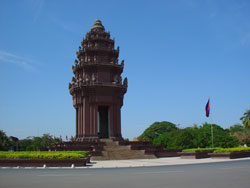
It commemorates the end of Cambodia's rule by France in 1953. The Naga (Total 100) or snake motif is one which can be seen in historic, cultural and modern day business contexts, as a symbol of the Country. It's also used to commemorate to the soul of fallen combatants who laid down their lives for freedom of the country.
WAT UONALOM
This pagoda is famous for its appealing works of art.
The monastery also serves as a center for the Cambodian Buddhist Society. In Cambodia there are two school of Buddhism known as : Mahanikaya and Dhamayoka. Mahanikaya is perceived as stricter and more obedient that Dhamayoka Buddhism. There is a beautiful panoramic view over the confluence of the rivers from the top this Monstery, And this temple is the place where Supreme Buddhist Monk in Cambodia stays.
NATIONAL MUSEUM

The distinctive red building with beautiful Khmer architecture was officially inaugurated on April 1920. Today the Museum contains more than 5000 of art objects that have been collected and conserved from all over the country and which are on display to visitors. The artifacts date back from pre-historic to the late 20th century. Most of these works of art are made from sandstone, bronze, silver, copper, odor, or pottery.
TOUL SLENG or (S-21)

When tortured prisoners became unconscious they were dragged out here and either tied by the feet or their hands behind their backs and repeatedly their heads dumped into the putrid water held in the large pots. When they became conscious again, back to the torture rooms for more torture. The white graves in the background are those of the final victims, bodies found still chained to the beds when the Vietnamese liberated the camp after the guards ran away. 20,000 people passed through this torture camp - apparently 7 survived.I have thought long and hard about whether I should or should not post these photographs - the visit to this prison and to the infamous Killing Fields was really disturbing for me - and probably more so because I knew that this was happening - almost everyone across the world knew, the atrocities carried out by the Pol Pot regime was on the news all the time. Yet I (and the rest of the world) did nothing until the Vietnamese invaded Cambodia and ended it.
After the World War 2 Holocaust when many said 'Never Again' we have allowed similar events to happen again and again - even today we have a number of countries whose human rights behavior is beyond question, we still allow it. As an individual I don't know what I can do but as a group surely we must be able to do something.
BOENG CHOEUNG EK (Killing Field)

Located 15 km south of Phnom Penh city. This killing fields were used to bury the victims from Toul Sleng prison during the Khmer Rouge regime. This site is covered by mass graves. A memorial Stupa contains the remains of thesevictims.
SILVER PAGODA

A truly remarkable temple located within the terrain of the Royal Palace. Beside the English name, the Vihear is known to the Cambodians as Wat Preah Keo Marokat (the temple of Emerald Buddha). The silver pagoda is revered by Cambodians and appreciated by visitors as one of the most popular cultural spots in Phnom Penh. The King of Cambodia has made the majority of treasures available on display in this pagoda. in particular gifts from other countries. Among the major treasures on display is a 90 kilogram standing Buddha and the floor decorated with 2,086 decorative pure silver tiles weighting 1.15 kilogram each.
CENTRAL MARKET or PHSAR THMIE
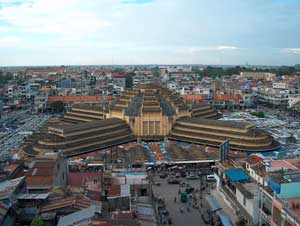
Well known to visitor for its magnificent colonial-style architecture, it was built in 1937. It provides a vast indoor shopping space. The design of the building actually has a meaning to it. The four cross wings of the building are said to represent the Chacktomouk Rivers (the intersection of four rivers in front of the Royal palace), which is the country’s economic body , and the two hands and two lege as compared to human.
RUSSIAN MARKET (PSAR TOUL TOM POUNG)
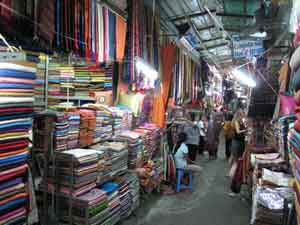
Less architectural interest but has a larger and more varied selection of souvenirs, curious and silk than Central Market. Russian Market offers the largest selection of boot-legged VCDs, DVDs and CDs of all the traditional markets. It’s also a good place to buy fabric for business and casual cloths to take to tailor. “Don’t forget to bargain!”.
PHNOM CHISO
Phnom Chiso is a historical site located about 62 kilometers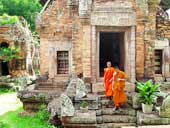
south of Phnom Penh. Phnom Chiso temple was built in the early 11th century by King Soryavarman I, who practiced Brahmanism. Constructed of sandstone and other stones, it is 60 meters long and 50 meters wide and sits atop a mountain. The temple is surrounded by two galleries. People usually climb the staircase on the west side of the mountain, which has 390 steps and descend by the south side staircase,which has 408 steps. In addition, there is a mountain cave, Vimean Chan, located about 150 meters south
of the temples. It is a quiet place for Brahmans or ascetics to meditate.
PHNOM TAMAO
The biggest national zoo and ancient temple is located about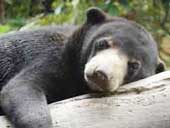
40 kilometers south of Phnom Penh. There are five mountains at this site-Phnom Tamao, Phnom Thma Dos, Phnom Pdaov Pun, Phnom Chhoy and hnom Bang. The entire site covers 2500 hectares, most of it is the protected forest area. Phnom Tamao national zoo covers 70 hectares and is under the supervision of the department. It features hundreds of birds, quadrupeds and reptiles. The animals, which include alligators, elephants, lions, tigers and bears, were collected by the Ministry of Agricultures accompanied by two ancient temples: Tamao Temple, Thma Dos Temple.
TONLE BATI

Tonle Bati is located about 35 Kilometers from Phnom Penh. Tonles Bati is a place of worship and features two ancient temples, Ta Prohm was built during the late 12th during the reign of King Jayavarman VII, and Yeay Peov is behind Wat Tonle, Wat Tonles bati, which was built it 1576.
PHNOM UDONG
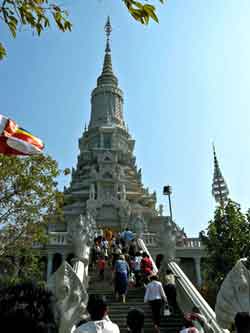
Is located in Kandal province and about 41 kilometers north of Phnom Penh. This site is of particular interest to visitors seeking to learn about early Cambodian history, Udong was home to several kings when it served as the Cambodian capital between AD 1618 and 1866. There are three manses for this hill: Phnom Udong, Phnom Preah Reach Troap and Phnom Ethareus. It offers more than an exhibit of ancient history.
| 





 Wat Phnom is one of the most important pagodas in Phnom Penh. Built in 1373,it stands at 27 meters and is the tallest religious structure in the city. Built on an artificial hill by the wealthy widow Daun Chi Penh after a great flood washed statues of Buddha downstream, it has since been renovated. There have been many additions to the original shrines over the centuries. The largest Stupa houses the ashes of King Ponhea Yat left the Angkorian capital and shoed interest in re-locating the capital city. The original name of Phnom Penh was Phnom Daun Penh in memory of the founder, but was often called Phnom Penh of short, From then on, this enchanting city has been known simply as Phnom Penh.
Wat Phnom is one of the most important pagodas in Phnom Penh. Built in 1373,it stands at 27 meters and is the tallest religious structure in the city. Built on an artificial hill by the wealthy widow Daun Chi Penh after a great flood washed statues of Buddha downstream, it has since been renovated. There have been many additions to the original shrines over the centuries. The largest Stupa houses the ashes of King Ponhea Yat left the Angkorian capital and shoed interest in re-locating the capital city. The original name of Phnom Penh was Phnom Daun Penh in memory of the founder, but was often called Phnom Penh of short, From then on, this enchanting city has been known simply as Phnom Penh.










